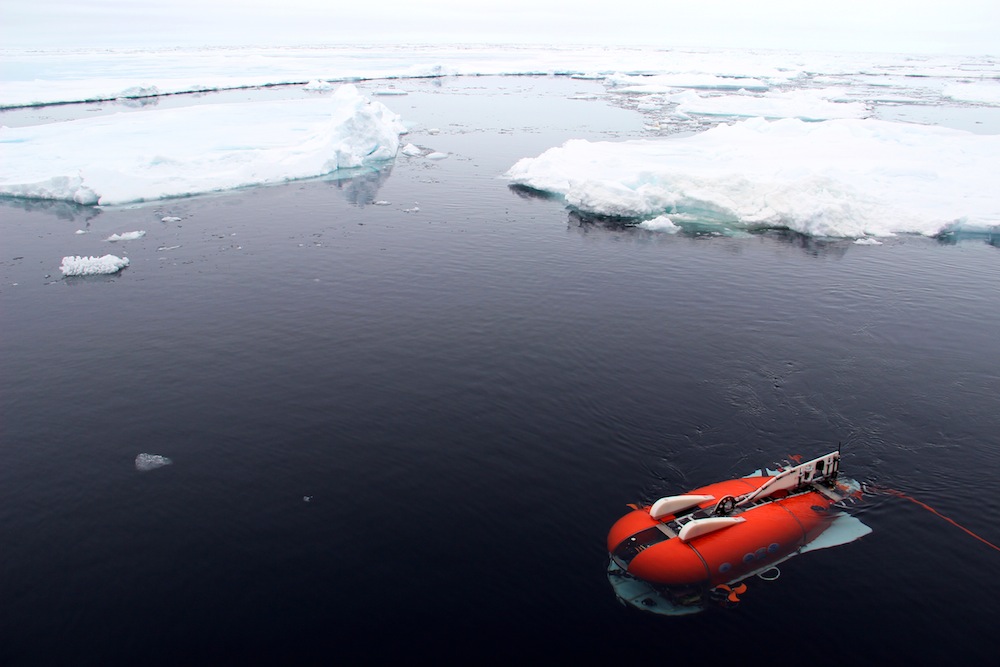Life Under Ice: Robot Captures Views of Hidden Arctic Ecosystem

SAN FRANCISCO — A nimble underwater robot has traveled below Arctic sea ice and collected the most extensive real-time video footage yet from this largely unexplored environment, revealing an unexpectedly rich ecosystem, scientists report.
Researchers have long known that algae and other small organisms thrive on the undersurface of Arctic sea ice — particularly in regions thin enough for sunlight to shine through and support photosynthesis. But, scientists have not been able to closely examine this environment in its pristine state, because the icebreakers they typically use to reach field sites tend to disturb the sea ice.
Researchers based at the Woods Hole Oceanographic Institution in Massachusetts have now built a new remotely operated vehicle (ROV), called the Nereid Under Ice (NUI) vehicle, that solves this problem by diving beneath ice and delicately transmitting oceanographic data and real-time video footage to researchers on a ship through a thin fiber-optic cable. [Life on Ice: Gallery of Cold-Loving Creatures]
Sixteen hours of video footage from the NUI vehicle’s first four trial runs this past summer revealed a surprising abundance of life under the ice, including algae, jellyfish, and gelatinous animals called larvaceans, the team reported here Tuesday (Dec. 16) at the 47th annual meeting of the American Geophysical Union.
"What might look on the surface like a barren wasteland may actually be a thriving ecosystem," study co-author Christopher German, a researcher at the Woods Hole Oceanographic Institution, told reporters in a news briefing.
The underwater robot’s thin fiber-optic cable is only about as thick as a human hair, and gives it more flexibility and finesse than typical ROVs with thicker tethers that usually only travel directly below a ship. During its trial runs, the NUI vehicle was able to travel as far as 2,600 feet (800 meters) laterally from the ship, and was able to complete 2.3 miles (3.7 kilometers) of track-line surveys, the team reported. If the cable breaks, the robot is programmed to find its way back to the ship autonomously.
The robot documented organisms that form not only the base of the Arctic food web that supports larger animals like seals and polar bears, but smaller organisms that also play an important role in the global carbon cycle, by pulling carbon dioxide out of the atmosphere and eventually dragging it to the seafloor when they die. This so-called biological pump helps mitigate the warming effects of fossil fuel emissions by drawing greenhouse gases out of the atmosphere, the researchers said.
Get the world’s most fascinating discoveries delivered straight to your inbox.
The scientists are using the NUI’s data to gather baseline information about this important sub-ice environment now, so they can better understand how its role in the global carbon cycle may change in the future, with thinning ice due to climate change.
"It’s one of these habitats that we have never seen before and we are understanding them as we are changing them," study researcher Antje Boetius, a marine biologist at the Alfred Wegener Institute in Germany, said during the news briefing.
The team is now working to analyze the data collected from the robot, and eventually hopes to equip the ROV to explore more extreme environments. The team's ultimate goal is to send it beneath the underbelly of a floating glacial tongue to study the region where a glacier meets the seabed, called its grounding line. A glacier’s grounding line plays an important role in the speed at which it melts and slips into a body of water, which has key implications for rising sea levels.
"Even just seeing that environment will offer a new kind of perspective, because it has not really been done before," WHOI researcher Michael Jakuba told Live Science. The team is particularly interested in exploring the base of Thwaites Glacier, an unstable region of the West Antarctic Ice Sheet, Jakuba said.
Follow Laura Poppick on Twitter. Follow us @livescience, Facebook & Google+. Original article on Live Science.




